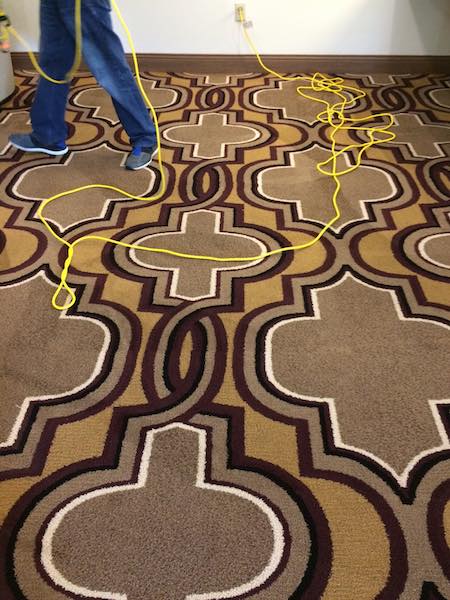Buying carpeting for an office space is a serious investment. We put in so much time and energy to find the right color, pattern and texture that will fit our specific flooring needs. However, we sometimes forget that the same effort is required for creating an effective maintenance program for those carpets.
We have carpet in our offices here at Geyen Group South and these maintenance rules apply to us as well as everyone who is responsible for keeping their commercial carpet clean and appearance friendly.
It is important to implement an adequate maintenance program from the beginning, right after the installation, because it can increase life expectancies and carpet performance. A lot of facility managers and maintenance supervisors have an ineffective plan for their carpet maintenance because they believe that it is quite enough to clean the carpet “when needed”. However, there is a huge difference between cleaning carpet just when it looks soiled and regularly maintaining the carpet. Soiling is a cumulative process which, if allowed to go too far, can irreversibly damage the fibers and cause carpet discoloration. Maintenance, in contrast to cleaning, is a scheduled on-going process of soil removal designed to maintain carpet’s daily appearance at a consistent level of cleanliness.
A customize commercial carpet maintenance program consists of five elements:

- Soil prevention – There are ways to minimize the amount of soil that get on your office space carpets. One of the best preventive measures of keeping the dirt off the carpets is using replaceable mats. Outside mats should have a coarse texture capable of scraping debris off shoes and inside mats should be absorbent in order to prevent tracked-in moisture from getting into the carpet.
- Routine vacuuming – Vacuuming is one of the most effective methods of removing dirt from carpet and therefore a very important part of the well designed maintenance program. However, there is a lot more to it than just simply vacuuming the dusty areas in your office space. In order to get the best and long lasting results, you need to determine the right vacuuming frequency and choose equipment that will have the biggest impact on the upkeep of your carpet. High traffic areas (entrances and exits, hallways and corridors, cafeterias, waiting rooms, elevator lobbies, etc.) should be vacuumed daily, moderate traffic areas (conference rooms, secondary aisles, etc.) two or three days a week and low traffic areas (boardrooms, conference rooms, executive offices etc.) should be vacuumed when needed or at least once a week. The right equipment should have high airflow, high efficiency filtration and an adjustable rotating brush agitation for more effective soil removal.
- Spot removal – Removal of spots and spills on a regular basis helps maintain the carpet’s appearance. Also, immediate action is definitely preferable when it comes to spot removal. The quicker you get to a spot or a spill the chances are smaller that the damage will become permanent. If you do not have proper chemicals on your hand, use our guide which is based on our experience with readily available household products. However, some stains do require professional help like ketchup, mustard, glue residue, dyes, etc. So, do not hesitate to call commercial cleaning experts to tackle this kind of spots and spills.
- Preventive cleaning – Carpet in high traffic areas must be cleaned more frequently. Regular use of adequate preventive cleaning measurements can prolong the life of your office space carpets and postpone the need for deep cleaning. Every effective preventive cleaning program should include these steps: remove soil and stains from the carpet, deodorize and neutralize bacterial contaminants, use advanced carpet protector based on manufacturer’s suggested frequencies, pile lift carpet fiber to restore matted carpet and loosen embedded dirt and move and replace furniture as needed.
- Deep cleaning – Deep cleaning is a carpet cleaning process that removes dirt, soil and ground-in grit which can irreversibly damage the carpet fibers. This process extracts both embedded and accumulated soils and chemical residues. Deep cleaning should be implemented before the dirt in the carpet is apparent to the naked eye. Frequencies of deep cleaning depend on degree of carpet soiling, carpet age, environmental conditions, traffic intensity and manufacturer’s requirements.

